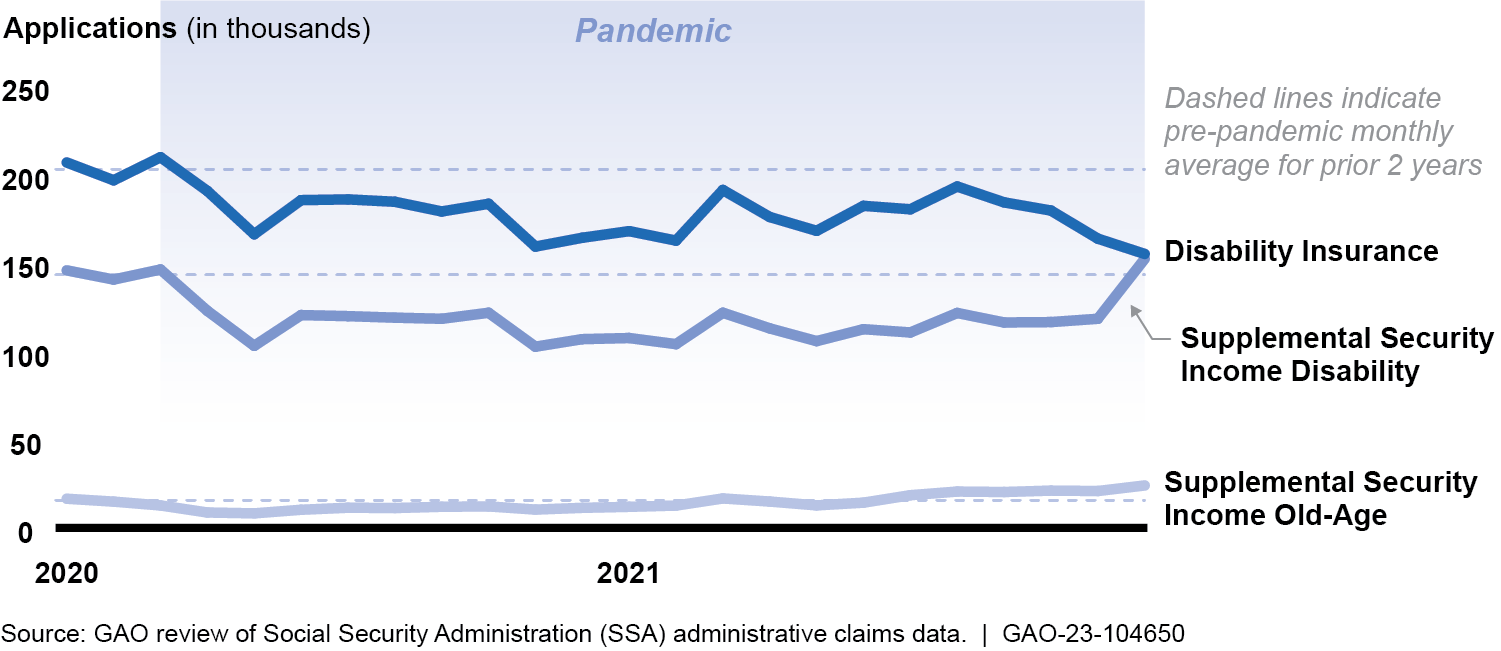
Social Security Administration: Remote Service Delivery Increased during COVID-19, but More Could Be Done to Assist Vulnerable Populations
What GAO Found
COVID-19 prompted the Social Security Administration (SSA) to make dramatic changes in the way it delivers services and administers its programs. On March 17, 2020, SSA closed its offices to the public—providing limited in-person visits for individuals with certain critical needs—and expanded remote service delivery options. SSA increased its use of telephone, mail, video, and online services. Through 2021, SSA established policies at field offices to increase the use of inoffice appointments. SSA also worked with state agencies that process claims for disability benefits to offer video options for certain medical exams. In April 2022, the agency reopened field offices to walk-in visits from the public.
The public filed fewer benefit claims with SSA during the pandemic, on average, compared to the prior 2 years, particularly for certain benefits and among certain vulnerable populations, according to GAO’s analysis of SSA data. For example, compared to the 2 years before the pandemic began, average monthly claims were lower from March 2020 through December 2021 for several SSA benefits. Specifically, they were 18 percent lower for Supplemental Security Income disability benefits, 12 percent lower for Disability Insurance, and 8 percent lower for Supplemental Security Income Old-Age, though Supplemental Security Income claims rebounded in late 2021. Some types of benefits claims declined more for certain populations, such as Spanish speakers.
SSA took steps to address a range of challenges with providing services remotely, but gaps remain in delivering services online and assessing lessons learned. SSA targeted outreach to certain vulnerable populations and expanded the use of third parties to help the underserved access benefits and services. However, not all claimants are able to apply for SSI online and applications in Spanish cannot be submitted online. As a result, SSA cannot fulfill its mission to ensure that its services are equitable and accessible, and some eligible individuals may not apply for benefits. Some SSA offices have assessed specific service delivery changes, but the agency does not have a coordinated process for assessing lessons learned from the COVID-19 pandemic and taking related corrective actions, which could leave SSA vulnerable to other crises in the future.
Why GAO Did This Study
In 2020, SSA provided benefits to nearly 70 million individuals. Under the CARES Act, SSA received $300 million to prevent, prepare for, and respond to COVID-19. The CARES Act includes a provision for GAO to monitor federal efforts to respond to the COVID-19 pandemic. GAO was also asked to review SSA’s response.
This report examines (1) changes SSA made to its delivery of key services; (2) the effect of these changes on the public, including certain vulnerable populations; and (3) how SSA addressed challenges it faced and identified lessons learned. GAO analyzed summary and administrative SSA data from March 2018 to December 2021, and reviewed the agency’s plans, policies, and guidance documents. GAO also conducted group interviews with SSA staff at various levels and offices; and interviewed SSA officials and external stakeholders, including disability advocates and employee groups.
What GOA Recommends
GAO is making five recommendations, including that SSA develop detailed plans to enable claimants to apply for SSI online, evaluate the feasibility of making existing online applications available in Spanish, and implement a coordinated process for assessing lessons learned from the COVID-19 pandemic and incorporating them into future plans. SSA agreed with our recommendations.

